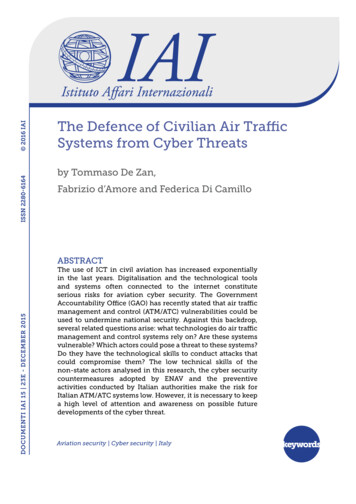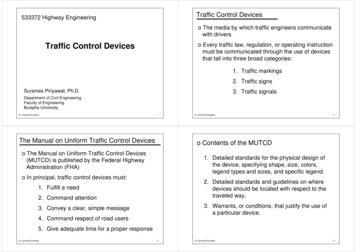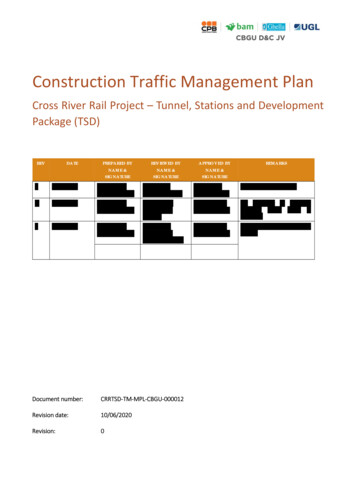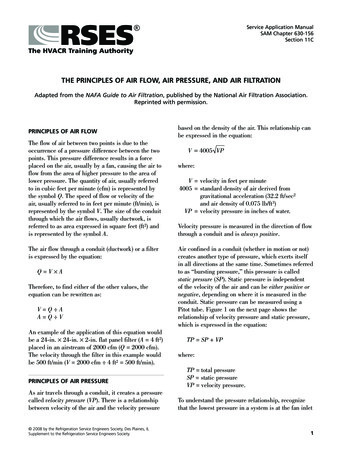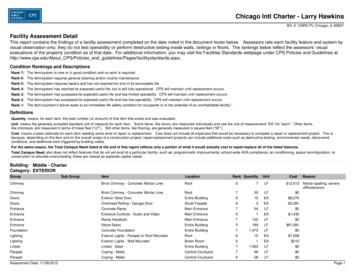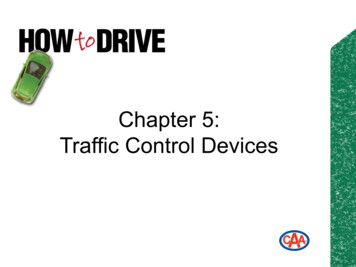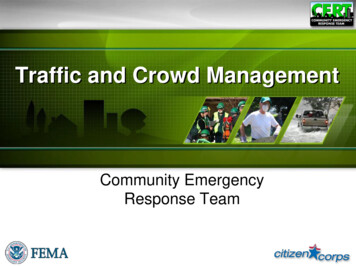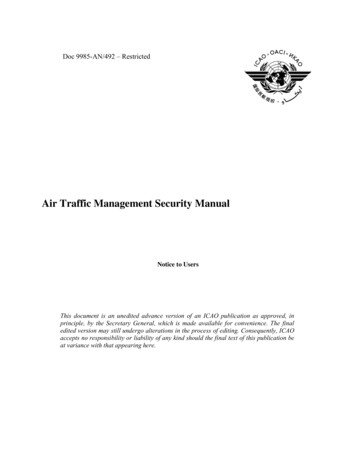
Transcription
Doc 9985-AN/492 – RestrictedAir Traffic Management Security ManualNotice to UsersThis document is an unedited advance version of an ICAO publication as approved, inprinciple, by the Secretary General, which is made available for convenience. The finaledited version may still undergo alterations in the process of editing. Consequently, ICAOaccepts no responsibility or liability of any kind should the final text of this publication beat variance with that appearing here.
FOREWORDStandards and Recommended Practices (SARPs) related to maintaining the security of civil aviationoperations were first adopted by the International Civil Aviation Organization (ICAO) Council on22 March 1974 and published as Annex 17 — Security — Safeguarding International Civil Aviationagainst Acts of Unlawful Interference to the Convention on International Aviation. The provisions of thisAnnex require, inter alia, States to establish and implement a National Civil Aviation Security Programme(NCASP).The applicability of the NCASP was initially limited to aircraft operators and airports, focusing primarilyon hijacking and bomb threats. However, following the use of aircraft themselves as weapons in thedestruction of the New York City (USA) World Trade Centre on September 11, 2001, there has been aheightened awareness of the possibility of other types of security-related events, including the possibilityof similar attacks, or attacks against air traffic service facilities and the navigation and surveillanceinfrastructure.Therefore, in response to aviation security concerns, the ICAO Council, on 17 November 2010, adoptedAmendment 12 to Annex 17. This required States to include ATSPs in the NCASP and to ensure that theyimplement appropriate security provisions to meet the requirements of the NCASP.There has also been an increase in the frequency that air traffic service providers (ATSPs) are asked tosupport various types of national security and law enforcement operations. This support often requires theestablishment of temporary airspace/flight restrictions for security-related purposes such as: protecting themovements of Heads of State; conducting airborne surveillance and monitoring operations, often withUnmanned Aircraft Systems (UASs); restricting access of unvetted aircraft to airspace surrounding majorsporting events and other large-scale public gatherings; or provision of information that supports airspacemanagement for security related purposes. ATSPs need guidance concerning provision of services relatedto security operations. Beyond this, ATSPs also need guidance on pr otection of air traffic management(ATM) system infrastructure that supports international aviation.This manual complements the Aviation Security Manual (Doc 8973–Restricted) and provides guidance onsecurity issues specific to ATM in order to assist States and ATSPs in implementing appropriate securityprovisions to meet the published requirements of the NCASP. In addition, the manual provides guidanceto the ATSP on provision of ATM security services in support of national security and law enforcementrequirements, and guidance on protection of the ATM system infrastructure from threats andvulnerabilities.
OVERVIEWThe first decade of the twenty-first century has seen an increase in terrorist activity against a range oftargets using a variety of methods. These have ranged from the use of explosive devices in attacks againstaircraft, trains, and buildings, to cyber-attacks against information and communications systems. As aresult, a number of States have expressed concerns about the possibility that the air traffic management(ATM) system could be subject to attack, and safeguarding the ATM system from security threats hasbecome an issue of increased concern. At the same time, air traffic service providers (ATSPs) have alsobeen more frequently involved in supporting roles in national security and law enforcement situations,including disaster prevention and recovery operations that are not intentionally directed at the aviationsystem, but could have profound, negative impacts on the aviation system if not managed effectively.These situations often require use of ATM procedures such as temporary airspace/flight restrictions thatprovide required safety and security measures and minimize the impacts of security events on flightoperations in the ATM system.I.The International Legal Basis for Aviation SecurityBecause of the international nature of aviation, effective security requires the participation of all States. Inorder to achieve a u niform application of security provisions, several international legal instruments(conventions) have been developed. They provide the basis for the uniform implementation of securityprovisions worldwide.The following conventions deal specifically with unlawful interference with aircraft:a) The Convention on Offences and Certain Other Acts Committed On Board Aircraft. (theTokyo Convention), signed in Tokyo on 14 September 1963.b) The Convention for the Suppression of Unlawful Seizure of Aircraft (The HagueConvention), signed in The Hague on 14 October 1971.c) The Convention for the Suppression of Unlawful Acts against the Safety of CivilAviation (the Montreal Convention), signed in Montreal on 23 September 1971.d) The Protocol for the Suppression of Unlawful Acts of Violence at Airports ServingInternational Civil Aviation, Supplementary to the Convention for the Suppression ofUnlawful Acts against the Safety of Civil Aviation, done at Montreal on 23 September1971, done at Montreal on 24 February 1988.e) The Convention on the Marking of Plastic Explosives for the Purpose of Detection, doneat Montreal on March 1991.f) The Convention on the Suppression of Unlawful Acts Relating to International CivilAviation (the Beijing Convention), signed in Beijing on 10 September 2010.g) The Protocol Supplementary to the Convention for the Suppression of Unlawful Seizureof Aircraft (the Beijing Protocol), signed in Beijing on 10 September 2010.
These conventions cover a wide range of types of unlawful interference with aircraft, air navigationfacilities, and airports.In the present context, the most important aspect of the provisions contained in these conventions is thatthey place an obligation on the States party to them to enact legislation to make the acts defined in theconventions offences punishable by severe penalties under the laws of those States.II.State Responsibilities for Aviation SecurityLegislationThe first step for a State in establishing aviation security is the enactment of the legislation necessary togive effect to these conventions. Since Standards and Recommended Practices (SARPs) relating toaviation security first became applicable in 1975, this legislation should generally be in place already.However, when implementing ATM security for the first time, States should check that the relevantlegislation adequately covers acts of unlawful interference with air traffic service facilities, and provisionof ATM security services required by the National Civil Aviation Security Programme (NCASP).While the creation of offences and the imposition of penalties for acts of unlawful interference withaviation are important, it is also important to put measures in place to ensure that, to the extentpracticable, the entire aviation system is protected against security threats. No security system canguarantee that the protective measures will be able to prevent all attacks, so it is necessary that securityplanning includes the development and implementation of procedures for responding to incidentsinvolving unlawful interference.National Civil Aviation Security Programme (NCASP)Annex 17 r equires States to develop and implement an NCASP, which should specify the roles andresponsibilities of all the organizations and agencies, including ATSPs that may be involved in securityoperations. The NCASP addresses the whole range of security activities including, inter alia, threat andrisk assessment, staff selection and training (in security-related matters), access control and otherpreventive security measures, management of acts of unlawful interference, and quality control.Not all provisions of the NCASP will be applicable to the ATSP. The NCASP identifies the specificresponsibilities of each of the parties that have a role in security operations.ICAO has developed a model NCASP to act as a guide for the States. The model NCASP is published inDoc 8973–Restricted.To ensure the effectiveness of the NCASP, each State must enact legislation establishing an appropriateauthority for aviation security. This authority will then be responsible for developing the NCASP andamending it when necessary. It must also enact legislation requiring those parties with responsibilitiesunder the NCASP to implement appropriate security provisions to meet the requirements of the NCASP.The National Civil Aviation Security CommitteeBecause the maintenance of security across the whole aviation system involves a large number ofdifferent agencies and organizations, Annex 17 requires States to establish a N ational Civil Aviation
Security Committee. The role of this committee is to facilitate coordination of security activities amongthese different agencies and organizations. The membership of this committee comprises representativesof all parties with a role under the NCASP. Depending on how services are structured in a p articularState, this may include (in addition to the appropriate authority for aviation security) members from thefollowing groups:a) ATSPs;b) aircraft operators;c) airport operators;d) customs authorities;e) Immigration authorities;f) intelligence organizations;g) Law Enforcement Authorities (LEA);h) Military; andi) providers of contracted security services.Airport Security CommitteeIn addition to the National Civil Aviation Security Committee, Annex 17 requires the establishment of anairport security committee for each civil airport. The local air traffic services (ATS) unit should berepresented on this committee.International coordinationAlthough aviation security remains a national responsibility, the increased possibility of internationalthreats makes it necessary to maintain a high level of cooperation among States. The appropriate authorityfor civil aviation security should establish coordination procedures with corresponding authorities inadjacent States, and agreements should be established concerning the exchange of security information.ATS units should already have established Letters of Agreement (LOAs) with adjacent ATS units withinone State or in other States, detailing the communications and coordination procedures. If these LOAs donot already address procedures related to security, they should be updated as part of the planning forimplementation of ATM security procedures.This collaborative, cooperative approach is necessary to ensure that ATM security management policiesand provisions will be able to successfully counter a w hole range of acts of unlawful interference,terrorism, or other events which threaten persons or facilities or could result in the disruption of the ATMsystem’s ability to provide services.III.Distinctions Between Aviation Security and ATM Security
This manual provides guidance on ATM Security with the objective of assisting States and ATSPs in (1)implementing aviation security SARPs, (2) protecting ATM system infrastructure, and (3) executingadditional security related functions.Aviation Security DefinitionDoc 8973–Restricted states that the primary objective of aviation security is: “ ensuring the protectionand safety of passengers, crew, ground personnel, the general public, aircraft, and airport facilities.1”Aviation Security Standards and Recommended Practices (SARPs)The Ninth Edition of the ICAO Annex 17 (Security - 2011) recognizes the important role ATSPs have inaviation security by introducing the following two SARPs in the Amendment 12:“3.5 Air traffic service providers. Each Contracting State shall require air traffic service providersoperating in that State to establish and implement appropriate security provisions to meet therequirements of the national civil aviation security programme of that State.”“4.9 Measures relating to cyber threats. Recommendation - Each Contracting State should developmeasures in order to protect information and c ommunication technology systems used for civilaviation purposes from interference that may jeopardize the safety of civil aviation.”All SARPs in Annex 17 are applicable to international operation. Additionally, States are also required toensure that measures designed to safeguard against acts of unlawful interference are applied to domesticoperations, to the extent practicable, based on a security risk assessment carried out by the relevantnational authorities.ATSPs contribute to aviation security in the prevention of, and response to acts of unlawful interference.This contribution to aviation security usually involves ATSP airspace management for ATM securitypurposes. Specific ATSP responsibilities for airspace management for ATM security purposes should beidentified in agreements with air defence and law enforcement agencies to ensure proper integration ofresponsibilities of all agencies directly responsible for the state’s airspace security. Secure airspace is oneof the layers of defence along with the ground-based security of aircraft, people, baggage, cargo/mail, andthe airport and other aviation related infrastructure.Aviation security is supported by ATM security in its concerns with safeguarding civil aviation againstacts of unlawful interference. Acts of unlawful interference are acts or attempted acts such as tojeopardize the safety of civil aviation and include, but are not limited to:a) unlawful seizure of aircraft in flight or on the ground;b) destruction of an aircraft in service;c) hostage-taking on board aircraft or on aerodromes;1Aviation Security Manual (Doc 8973–Restricted)
d) forcible intrusion on board an aircraft, at an airport or on the premises of an aeronauticalfacility;e) introduction on boa rd an aircraft, or at an airport of a weapon, hazardous device, ormaterial intended for criminal purposes;f) use of an aircraft in service for the purpose of causing death, serious bodily injury, orserious damage to property or environment; andg) communication of false information that jeopardizes the safety of an aircraft in flight oron the ground, passengers, crew, ground personnel, or the general public at an airport oron the premises of a civil aviation facility.ATM Security DefinitionATM security concerns a broader range of issues than just aviation security. ATM Security is defined inICAO Circular 330, Civil/Military Cooperation in Air Traffic Management as:“The contribution of the ATM system to civil aviation security, national security and defence, andlaw enforcement; and the safeguarding of the ATM system from security threats andvulnerabilities.”The Dual Requirements of ATM SecurityATM security differs from aviation security in the sense that ATM security has dual requirements ofprotection of the ATM system against threats and vulnerabilities and the provision of ATM securityservices in support of organizations and authorities engaged in aviation security, national security,defence, and law enforcement. Thus, the ATM security role has a traditional internal role of protection ofthe ATM system itself and an operational role in the support of certain aspects of aviation security as wellas national security and law enforcement.IV.The Scope of ATM SecurityIn order to set the context within which ATM security provisions operate, this section provides an ATMsecurity operational concept, and then concludes with a summary of the ATM security scope.ATM Operational Concept for SecurityThe security role of ATM is recognized as a n essential component of the future ATM system in theGlobal Air Traffic Management Operational Concept (Doc 9854). This document outlines a role forATM security beyond aviation security to meet national security requirements, assist in protecting againstintentional and unintentional threats, and provide continuity of service during security threats and unusualcircumstances. It also emphasizes the contribution by the ATM provider to ATM security, and for theprotection of the ATM system against this broader range of threats.National Security
The ATM system should meet national security requirements outlined in the following statement of theICAO vision for the integrated, harmonized, and globally interoperable ATM system:“To achieve an interoperable global air traffic management system, for all users during all phasesof flight, that meets agreed levels of safety, provides for optimum economic operations, isenvironmentally sustainable and meets national security requirements.”Threat Protection and Security ServiceDoc 9854 d efines security as protection against both intentional (e.g., unlawful interference) andunintentional threats. It also emphasizes the need for the ATM provider to contribute to security, and forthe protection of ATM system against this broader range of threats.“Security refers to the protection against threats that stem from intentional acts (e.g., terrorism) orunintentional acts (e.g., human error, natural disaster) affecting aircraft, people or installations onthe ground. Adequate security is a major expectation of the ATM community. The ATM systemshould therefore contribute to security, and the ATM system, as well as ATM-related information,should be protected against security threats.”Continuity of ATM ServiceDoc 9854 lists continuity of service as one of the guiding principles for the on-going development of theATM system. The protection of the ATM system infrastructure is required to ensure, to a r easonabledegree, the availability, integrity and continuity of this critical service against a variety of threats. It statesthe following:“The realization of this concept [continuity of service] requires contingency measures to providemaximum continuity of service in the face of major outages, natural disasters, civil unrest, securitythreats or other unusual circumstances.”Other Security ServicesDoc 9854 lists other essential entities that the ATM system will provide information to or may receiveinformation from. These include the following within the security domain:Air defence systems and military control systems will need timely and accurate information on flights andATM system intents. They will be involved in airspace reservations, notification of air activities and inenforcing measures related to security.Search and rescue organizations will need timely and accurate information on aircraft in distress andaccidents. Such information plays an important role in the quality of the search function.Aviation accident/incident investigation authorities will need to examine recordings of flight trajectorydata and ATM actions.Law enforcement (including customs and police authorities) will need flight identification and flighttrajectory data, as well as information about traffic at aerodromes.
Regulatory authorities will need to implement the regulatory framework within the legal powers given tothem and to monitor the safety status of the ATM system.ATM Security Scope –the SummaryATM security includes security services captured in aviation security SARPs and the broader expectationoutlined in Doc 9854. ATM security includes the:a) safeguarding of the ATM system from security threats and vulnerabilities (ATMprotection); andb) provision of security services that contribute to civil aviation security, national security,defence, and law enforcement (ATM security operations).ATM protection refers to internal security services provided and consumed by the ATSP. Some examplesof internal security services by the ATSP:a) cyber security services to protect cyber systems; andb) physical protection of facilities.ATM security operations for external security services provided by the ATSP but consumed by Stateagencies, partners, and stakeholders. Some examples of external security services are:a) support for air defence interdiction;b) search and rescue efforts;c) aiding law enforcement response (e.g., border protection);d) air traffic control (ATC) during unlawful interference to aircraft in flight;e) VIP movements; andf) support for emergency response to natural disasters.Organization of the ManualIn line with the dual nature of ATM security as d escribed above, the remaining part of this manualconsists of the following:a) glossary: acronyms and definitions;b) Part A: Protection of ATM System Infrastructure;c) Part B: ATM Security Operations; andd) appendices.
Table of ContentsGlossaryPART A: ATM SYSTEM INFRASTRUCTURE PROTECTIONChapter 1.1.11.2Chapter 2.2.12.22.32.42.5Chapter 3.3.13.23.3Chapter 4.4.14.24.3Chapter 5.5.15.25.35.4Chapter 6.6.16.26.36.46.5IntroductionBackgroundPrinciples for ATM system infrastructure protectionGovernance and organizationProgramme objectivesState responsibilitiesRegulatory driversPolicyStructure, authority and responsibilityFacility physical securityIntroductionFacility physical security and access controlFacility layers of defence and mitigation optionsPersonnel securityIntroductionAviation security requirementsPersonnel security programmeInformation and communication technology (ICT) system security (including cybersecurity)IntroductionBackgroundInformation and communication technology (ICT) security controlsNext Generation ATM system considerationsContingency planning for ATM securityIntroductionRoles and responsibilities between States and ATSPsAir traffic service backup plans for ATM securityContingency planning framework for ATM securityGeneric requirements for contingency options
PART B: ATM SECURITY OPERATIONSChapter 7.7.17.27.3IntroductionBackgroundInteragency collaborationSpecial planning considerationsChapter 8.8.18.28.38.4ATM contribution to safeguarding against unlawful interferenceThe security role of the ATSP in relation to other OrganizationsATM security functions for aviation securityStrategic operations security functionsTactical operations security functionsChapter 9.9.19.29.3ATM support for law enforcementOverviewLaser threatsMan-portable air defence system (MANPADS) threatsChapter 10.Disasters and public health emergencies10.1 ATM support for disaster response and recovery10.2 Communicable disease and other public health risks on board aircraftChapter 11.Airspace management for ATM security11.1 Monitoring and reporting over security identification zones11.2 Emergency security control of air traffic11.3 Creation, promulgation and monitoring of temporary airspace/flight restrictionsChapter 12.12.112.212.312.412.5Organizing for effective ATM security operationsOverviewStrategic security planning and operationsTactical security operationsSpecial interoperations security for civil, military and law enforcement operationsATM security operations administrationAppendix A: Security risk management process1.2.3.IntroductionSecurity risk management processSecurity risk management – organizational collaboration
Appendix B:1.2.3.4.Cyber security in ICT securityIntroductionConcepts and definitionsCyber ICT security requirementsSecurity measures for critical cyber ICT infrastructureAppendix C: ICT security controls1.2.3.IntroductionControl categoriesLevel of controlsAppendix D: National and regional examples of provision for ATM security services1.2.3.In-flight security incident management framework in EuropeIn-flight security event procedures in the United KingdomUnited States domestic events network procedures
MNSAPANSRPGRTFAutomatic dependent surveillance — broadcastAutomatic dependent surveillance — contractAir traffic controlAutomatic terminal information serviceAir traffic managementAir traffic servicesAir traffic service providersConfidentiality, integrity and availabilityCivil aviation authorityChemical, biological, radiological and nuclearCommunications, navigation, and surveillanceLoss of radio communicationsController-pilot data link communicationsEstimated time of arrivalEuropean UnionFlight information regionFlight levelHeating, ventilation and air-conditioningInternational Civil Aviation OrganizationInformation and communication technologyIdentification feature in the identification, friend or foe (IFF) systemImprovised explosive deviceIdentification, friend or foeIn-flight security officerInformation technologyLaw enforcement authorityLetter of AgreementMan-portable air defence system(s)Memorandum of AgreementMemorandum of UnderstandingNavigational aidNational civil aviation security programmeNext generation air transportation systemNational governmental authorityNotice to AirmenNational supervisory authorityProcedures for air navigation servicesRocket-propelled grenadesRadio transmission facility
ds and recommended practicesSingle European sky ATM researchStandard operating procedureSafety risk managementSecondary surveillance radarSystem-wide information managementTrack of interestUnmanned aircraft system(s)Visual flight rulesVery high frequencyVery important personVHF omnidirectional radio rangeWorld Health Organization————————
EXPLANATION OF TERMSAir Domain. The global airspace; all manned and unmanned aircraft operating in the global airspace; allpeople and cargo present in the global airspace; and all aviation-related infrastructure.Air traffic service provider (ATSP). Annex 17 uses the term ATSP in the Amendment 12 Standard foraviation security. Therefore, this manual uses the term ATSP to be consistent with the ICAO Standard.However, States that must use the term air navigation service provider (ANSP) by law should substituteANSP for ATSP. ANSP should be considered synonymous with ATSP as used in this manual.Air traffic management (ATM). The dynamic, integrated management of air traffic and airspaceincluding air traffic services, airspace management and air traffic flow management – safety,economically and efficiently – through the provision of facilities and seamless services in collaborationwith all parties and involving airborne and ground-based facilities.Air traffic management system. A system that provides ATM through the collaborative integration ofhumans, information, technology, facilities and services, supported by air and ground- and/or spacedbased communications, navigation and surveillance.Air traffic management security. The safeguarding of the ATM system from security threats andvulnerabilities; and the contribution of the ATM system to civil aviation security, national security anddefence, and law enforcement.Airspace management for ATM security. Management of airspace to:a) deter, prevent, detect and resolve where possible airborne threats including those associatedwith unlawful interference;b) provide for emergency security control of air traffic; andc) initiate and monitor temporary airspace/flight restrictions in support of national security andlaw enforcement activities.ATM system infrastructure. ATM system infrastructure includes people, procedures, information,resources, facilities, including control centres, airports and equipment, including communications,navigation and surveillance (CNS) and information systems.ATM system infrastructure protection. The protection of the ATM system infrastructure throughinformation and communication technology (ICT) security, physical security and personnel security.Information and communication technology (ICT). ICT is an umbrella term that includes anyinformation or communication device (analogue or digital) or application, encompassing: radio,television, telephones (including smartphones), computer and network hardware and software, datastorage systems and devices, satellite systems, surveillance systems, navigation systems, as w ell as thevarious services and applications associated with them.
ICT security. The application of security measures to protect information and data processed, stored ortransmitted in ICT systems (analogue and digital) against loss of confidentiality, integrity of availability,whether accidental or intentional, and to prevent loss of integrity or availability of the systemsthemselves. ICT security measures include measures for protection of computers and networks (cybersystems), information and data transmission, emission and cryptographic security. ICT security measuresalso include detection, documentation and countering of threats to information and communications andto the ICT systems.Confidentiality means preserving authorized restrictions on access and disclosure, including meansfor protecting personal privacy and proprietary information.Integrity means guarding against improper information modification or destruction, and includesensuring information nonrepudiation and authenticity.Availability means ensuring timely and reliable access to and use of information.Physical security. The part of security concerned with physical measures designed to safeguard people;to prevent unauthorized access to equipment, facilities, material and documents; and to safeguard themagainst a security incident.Personnel security. The part of security concerned with procedures designed to assess whether anindividual can, taking into account his loyalty, trustworthiness and reliability, be authorized to have initialand continued access to classified information and controlled areas without constituting an unacceptablerisk to security.Aviation security. The safeguarding of civil aviation against acts of unlawful interference. Thisobjective is achieved by a combination of measures and human and material resources.Acts of unlawful interference. Acts or attempted a
Air Traffic Management Security Manual . Notice to Users . This document is an unedited advance version of an ICAO publication as approved, in principle, by the Secretary General, which is made available for convenience. The final edited version may still undergo alterations in the process of editing. Consequently, ICAO
